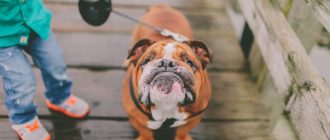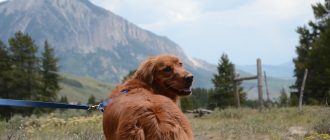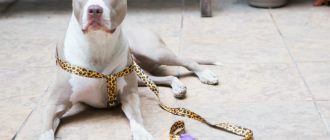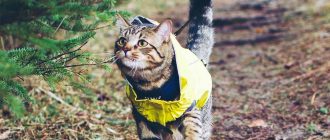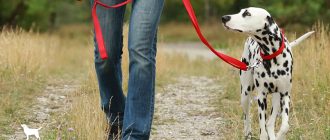If your puppy is gnawing on his leash, you may be wondering why. Read on to learn more about the puppy biting stage and how to deal with it. We’ll cover the basics, from how long the chewing phase lasts to whether you should let him chew the leash. And we’ll get into the most common causes of chewing. And we’ll discuss why your pup might be playing tug of war with the leash.
Why is my dog biting his leash?
There are several reasons why your dog may be nipping at his leash. During playtime, your dog may be engrossed in chewing or pulling on his leash. This behavior will stop when you firmly say “no” and distract your dog with a chew toy. If your dog continues to nip at his leash, it’s time to seek veterinary attention.
First, it may be because your dog is unused to wearing a leash. Getting your dog used to walking with a leash is part of their training process. They must get used to being tied while walking outdoors. Also, puppies may bite the leash out of rebellion, wanting more freedom to move around or feel safer. This behavior may seem frustrating, but it can be easily resolved. Try shortening walks or training sessions.
How long is the puppy biting phase?
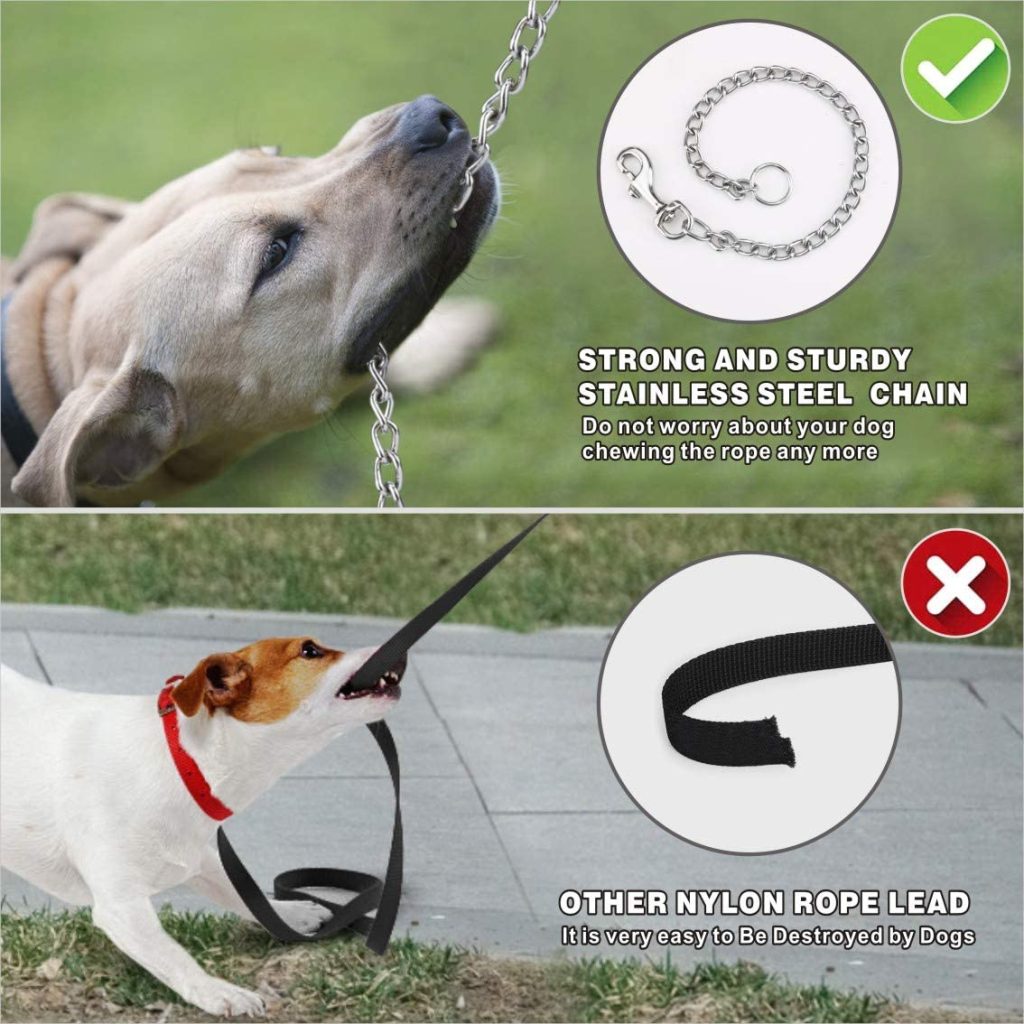
If your pup continues to bite on your fingers and toes, then this may be a sign that your puppy needs more socialization. The biting phase generally lasts between eight to ten months. Adult dogs do not use their mouths like a puppy, but there can be individual variations. Be patient and consistent, and remember to reward your puppy for good behaviour. Once your puppy has stopped biting, it will be ready to join you in your household.
Top-10 Dog Leashes
| Image | Price | Buy | Prime | Title |
|---|---|---|---|---|
 Top Top | Buy on Amazon | PrimeEligible | TUG 360° Tangle-Free Retractable Dog Leash | 16 ft Strong Nylon Tape | One-Handed Brake, Pause, Lock (Medium, White) | |
 Top Top | Buy on Amazon | PrimeEligible | BAAPET 2/4/5/6 FT Dog Leash with Comfortable Padded Handle and Highly Reflective Threads for Small Medium and Large Dogs (5FT-1/2'', Black) | |
 Top Top | Buy on Amazon | PrimeEligible | Fida Retractable Dog Leash, 16 ft Dog Walking Leash for Small Dogs up to 26 lbs, 360° Tangle Free, Black | |
 Top Top | Buy on Amazon | PrimeEligible | iYoShop Hands Free Dog Leash with Zipper Pouch, Dual Padded Handles and Durable Bungee for Walking, Jogging and Running Your Dog (Large, 25-120 lbs, Black) | |
 Top Top | Buy on Amazon | PrimeEligible | Mighty Paw Retractable Dog Leash 2.0 | 16' Heavy Duty Reflective Nylon Tape Lead for Pets up to 110lbs. Tangle Free Design W/One Touch Quick-Lock Braking System & Anti-Slip Handle (Green/Lite) |
As an Amazon Associate we earn from qualifying purchases.
The best way to teach your puppy not to bite you is to make sure you socialize it early. While your puppy may be a biter at first, this behavior will pass and will likely stop when the puppy reaches adulthood. For example, avoid leaving the puppy alone in a room with strangers or playing with other dogs until it is fully socialized. In the meantime, play with the puppy and reward it for its good behaviour.
Should I let my dog chew on his leash?
It is common for dogs to chew on their leashes, but there are a few different reasons why your dog might do it. The leash may be boring and not a good outlet for your dog’s energy, or he could be simply curious, trying to figure out what’s attached. No matter what the reason, there are several different solutions to this issue. If your dog is a chronic chewer, consider one of these alternatives.
A leash made of leather or another hard, non-chewable material may be less appealing to a dog. But if you let him, you might as well treat him! A chewy leash could actually lead to a serious injury. The more you leave this behavior alone, the harder it is to stop. Left untreated, leash-biting could escalate to biting clothing, arms and hands.
Why does my dog play tug of war with leash?
If you’ve ever wondered, “Why does my dog chew the leash?” there are many reasons. It could be due to boredom or curiosity. Or it could simply be that your dog likes chewing and you can’t resist its urge to play tug of war with you. Whatever the reason, there are ways to solve this problem. Here are some tips to help you stop your dog from chewing the leash.
– Try giving your dog a treat as soon as it stops biting the leash. This will get them to stop biting the leash, and will likely help them understand why it’s so painful. If that doesn’t work, try putting something unpleasant on it. Another solution is to use a chain leash, as dogs don’t like metal, and they can’t get their favorite ball with them.
How do I get my dog to stop chewing the leash?
Chewing the leash is a problem that many dog owners have to deal with. Dogs often chew the leash for no apparent reason, such as curiosity or to see what’s attached to it. Thankfully, there are some effective ways to help prevent your dog from misbehaving with the leash. Read on for a few tips and tricks. Listed below are some of the most common methods.
First, make sure you value the leash. If the leash is too difficult to handle, your dog may just need to get out and burn off some energy. If your dog is chewing the leash because it’s bored, you should use the leash for entertainment, or else the leash will become the target for further chomping. Often, chewing the leash is a social behavior, and you can prevent the unwanted behavior by redirecting the dog’s attention.
How to Stop My Dog From Chewing on the Leash

You might wonder: what age should I start leash training my puppy? Or how do I discipline a dog for chewing leashes? Or perhaps you’re curious as to why my dog keeps shaking his leash while walking? No matter the reason, here are some ways to help stop leash-biting behavior and teach your dog to make better choices. This will prevent relapses of old behaviors, and the results should be a gradual increase in your dog’s desirable behaviors.
What age to leash train a puppy?
Leash training a puppy can begin as early as eight weeks of age. The process can be started indoors with distractions before moving outside. It is normal for a puppy to chew on the leash, so clicker training is the best option for leash chewing. If your puppy insists on chewing, click and stop walking. This will prevent the puppy from chewing on the leash.
You should introduce the leash to your puppy gradually. The puppy will initially struggle with the leash, but eventually will accept it. This process is known as “classical conditioning.”
How do you discipline a puppy?
Puppies can be taught to resist chewing leash if the owner uses a positive reinforcement training method. When a puppy does not bite the leash, it should be rewarded with a treat. Then, try redirecting the puppy to better behavior. If a puppy repeats the misbehavior, the training should be intensified by providing more supervision and appropriate behavior opportunities. Remember that puppies are not human, so it is important to avoid triggering their “kill the moving object” instincts.
A dog should have a safe place to exercise. The puppy’s area should be warm and comfortable, not an isolated area like the basement or laundry room. It should be in the bedroom or kitchen. As a result, the puppy will be more likely to be more willing to behave when it is in that area. Another solution is to remove the leash when walking the puppy, but keep in mind that this is a slow and difficult process.
Should you punish your dog for biting?
The best way to handle your dog’s aggression is not to give in to it, but to address it. In order to stop your dog from chewing up your furniture and your belongings, you should first understand why they chew. The behavior is often caused by stress causes aggression. It is not a good thing to live in a stressful environment. You should also be aware that many biting dogs live long and happy lives.
Although physical punishment is an effective way to address aggression, it is not the best option for dogs that are afraid of the consequences. Physical punishment increases their fear and often reinforces the behavior they have been performing wrongly. Positive punishment can help prevent aggressive behavior, but it doesn’t deal with the fear and anxiety that trigger the behavior. Instead, you should seek professional help if you aren’t sure how to handle your dog’s aggression.
Why do dogs shake their leash?
If you are having trouble training your dog to stop shaking the leash, there are a few things you can do to help him overcome this behavior. It’s possible that he is frustrated and overly excited, which can cause him to snap at his leash. Another common cause is that he is frustrated with the training process. Dogs can get frustrated and lose their patience easily, so make sure you take shorter walks and training sessions.
Alternatively, you can try using a tug toy. Most of these toys contain food or treats, which will make your dog feel more interested. However, your dog might get bored with this toy and turn to the leash for fun instead. In addition, the leash will lose its appeal to your dog if it doesn’t smell like a treat or have something to play with. A good tip is to buy your dog a chew bone for kennel training.
Why does my dog grab the leash when walking?
Dogs are unique creatures and each may have different reasons for chewing the leash. In young dogs, overstimulation is the main culprit. They’re seeing and hearing things for the first time and become overly excited, which often leads to nipping and chewing. In such cases, you may consider taking the leash away and putting a dog backpack on your dog. It is essential to remember that your dog is a unique individual and may have different reasons for chewing the leash.
Sometimes, a dog may be exhibiting chewing behaviors because it is overexcited or frustrated. If you see this behavior in your pet, get down on its level and distract it with a toy or chew toy. Eventually, the behavior should stop. Until then, don’t give up hope. It will get better, but it may take a while. Eventually, a dog can learn to ignore the chewing leash without getting frustrated or angry.









